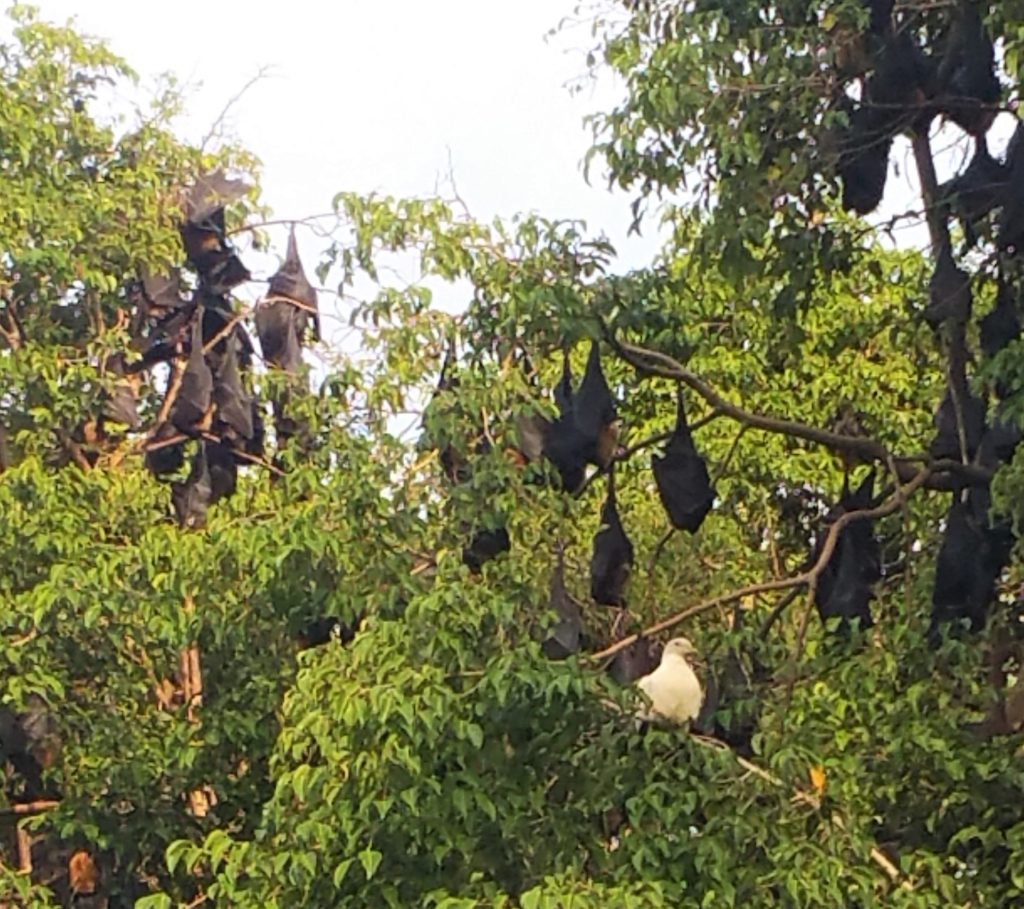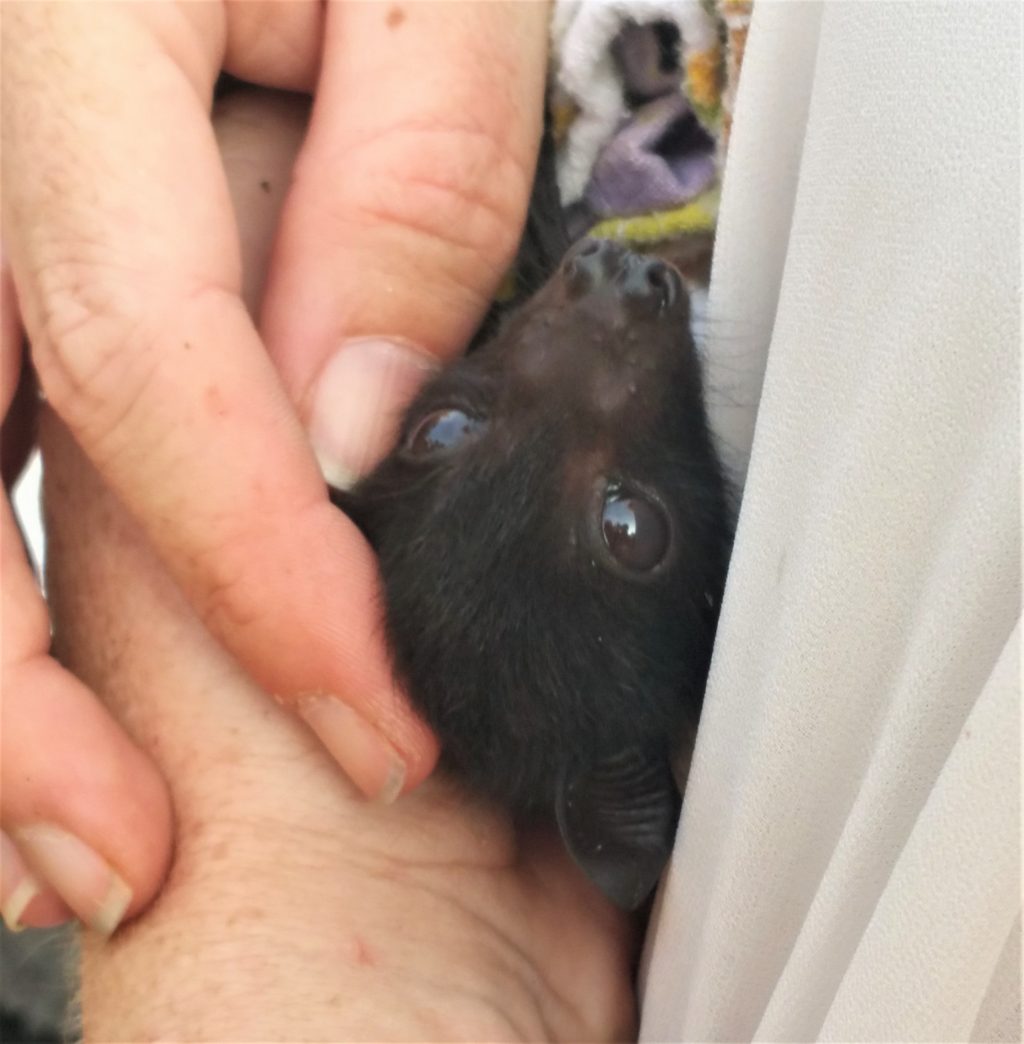
The most monumental fig trees I’ve ever seen, stand on the property of the Cairns Public Library in Queensland, Australia. These trees are such an impressive sight, it took my dazzled brain several minutes to notice that they were singing.
In the thicket of deep glossy green, a high pitched-clamor prompted me to look for a cluster of noisy birds, but I was wrong. Very wrong.
The Cairns library trees are a year-round roost site for thousands of bats, or what the Australians call Flying Foxes. Spectacled Flying Foxes and Little Red Flying Foxes spend their days hanging upside down (as they do), wrapped in their filmy black wings. I’ve been told they are napping but the noise and ruckus reminds me of the kind of “sleep” kids have at a slumber party.

When dusk falls, the din grows as the little critters prepare to leave for a night of sucking nectar from tree flowers because if you’re a flying fox, that’s what you do.
Day or night this is something to behold. But the absolutely best time to be at the library is as the evening sky turns deep blue and the tiny cylinder-shaped bats unfold their wings and take on the distinctive shape that triggers our chiroptophobia; a fear of bats a consequence of their depiction in literature and Hollywood movies.
As a crowd forms, some look on in awe, some with curiosity and some with alarm at a sky filling with the soaring silhouettes.
When I visited this northern Queensland community in October with my Australian friends, the Cogan family, it was for the same reason so many others do, to experience the great barrier reef with its hundreds of types of coral, fish, turtles, mollusks and sharks. The bats with their daylight shrieking and nighttime foraging were an unexpected extra.
Not everyone in town is enthusiastic about the bats. They are noisy for one and considered creepy to many. But perhaps most significant, their habitat may be standing in the way of building development. This is why wildlife advocates with the organization Batreach, have taken to setting up a table in the late afternoon, to explain to curious and skittish humans, not just the creatures they are about to see, but why they need to be protected.

“Spectacled flying foxes are only found in North Queensland within Australia and along with the cassowary, are vital to our tropical rainforests,” said Rebecca Koller, a Batreach volunteer and wildlife advisor to the town of Cairns. The bats are a keystone species dispersing seeds over a wide area and contributing to the area’s biodiversity.
 All is not well with the downtown bat colony, which occupies three large fig trees including one that hosts a maternal colony. As she cradled a bat pup in her hands, Rebecca told me she is seeing an increase in dead and premature babies. The bat pups fall from the trees onto the library lawn. The fortunate ones are rescued by Batreach though she and other volunteers are not always successful in nursing them back to health. This has her worried that recent development in the area is having a negative impact on the bats.
All is not well with the downtown bat colony, which occupies three large fig trees including one that hosts a maternal colony. As she cradled a bat pup in her hands, Rebecca told me she is seeing an increase in dead and premature babies. The bat pups fall from the trees onto the library lawn. The fortunate ones are rescued by Batreach though she and other volunteers are not always successful in nursing them back to health. This has her worried that recent development in the area is having a negative impact on the bats.
Construction of a large hotel and solar panels installed on the library roof caused a ruckus loud enough to rival the noise of the bats and several trees where bats used to live were torn down for a new hotel.

The loss of the trees condensed the animals into a much smaller space, Rebecca explained. “Many other trees the flying foxes used as habitat within the central business district have been cut down in the past few years, including some heritage-listed trees which Cairns council was fined for,” she said.
Accommodating tourists in places where wildlife and nature are the big attraction can be challenging. Cairns is not the first community to struggle balancing its unique environment with the tourism on which its economy is based.
“Federal laws protecting the species are grossly inadequate and we have applied to have the species upgraded to endangered,” Rebecca said. But if the bats “continue to drop in numbers at the same rate they have been for the past few years,” Rebecca predicts they will be extinct.
In Austin, Texas, the Spring to Fall residence of a million and a half Mexican free-tailed bats is embraced with bat tours by boat, restaurants touting tables with a bat-view and a bat hotline for visitor information. In Cairns by contrast, Batlife does its best with volunteers and the evening bat talks.

Despite the lack of government input, the volunteers host an entertaining and educational show. On the night we were there, a curious crowd surrounded Rebecca’s table, cooing at the bat pup in her arms and peppering her with questions. Then, as the sky filled and all eyes looked up in wonder, I suspect Rebecca enjoyed yet another night seeing minds stretching open, like the wings of the flying foxes, as new appreciation for bats took flight.


Author of The New York Times bestseller, The Crash Detectives, I am also a journalist, public speaker and broadcaster specializing in aviation and travel.


Wonderful, informative post, Chris! Thanks so much.
If they’re half as weird as the cassowary (which I saw once in the wild near Port Douglas), they deserve preserving and protecting; great post and pix. You have an eye for what’s worth seeing!